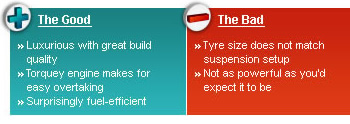Renault Laguna 2.0T Coupe (A) Review
26 Jun 2009|21,963 views
 |
The frontal edges frame an air intake that's both deep and functional. It moves back in order to create a gentle line that translates upwards over the front wheel arches to create a subtle but otherwise defined shoulder line.
That takes a slight dip downward behind the C-pillar, proceeds to diffuse into the leading rear edges of the car. All of that sweeps around gracefully, meeting the car's protruding rear lip just before it sweeps back up and over its roof, and back down onto the bonnet.
And so, the cycle is complete. But apart from reciting Bizet in falsetto, there are a little gnawing bits here and there. For example, the headlights remind me more of the Fiat Coupe 20v turbo that has been blown up 150-percent, and the back looks like an Aston Martin.
Unappealing is not the word though, because the Laguna Coupe ultimately makes the Peugeot 407 Coupe seem unattractive by comparison. Even your typical 3-series Coupe suddenly loses its executive appeal alongside it.
Fit and finish
The interior is the Laguna's biggest surprise. Like the 5-door hatch, build quality is an exacting match for the Germans. You could even try fitting a third person in between the rear bench and I'll bet he or she's going to be comfortable for the first 100 km or so.
Being a luxury coupe, it has everything that you might expect from one - well bolstered, ribbed beige leather seats that actually look hip and trendy rather than old and senile, a thick, luxurious steering wheel, bomb-proof panels, cupholders and other flap-openables; everything you can find in this car genuinely feels part of the theme.
Apart from the presence of ISOFIX child facilities, you might say there is reason to pick the coupe over the five-door hatch, even if you're a family of four. It's easy to get into the back. The front seats slide forward easily with one tug of a lever, and will electrically slide back into their previous position along the rails.
 |
Rear head and knee room is excellent for its class, and the "easy-pull" strategy stretches into the boot, where a tug of a small plastic handle lowers the rear seats flat for lots more boot space.
Driving Impressions
We can't complain despite the only choice being a 1,998 cc, turbocharged four-cylinder generating 170 bhp at 5,000 rpm and 270 Nm at 3,250 rpm, especially when it comes with Renault's 6-speed automatic transmission.
The self-shifter has a responsive, quick-shifting action never seen in anything since the French Revolution. It accurately predicts your throttle position in full auto, and makes fast enough gear-changes to not brand it a snail.
We timed the Renault's century dash at 9.6 seconds with a full load of gas on a hot day. It definitely feels faster than that given the nature of the force-fed unit. But unlike the benchmark 2-litre turbo from the Volkswagen-Audi group, there isn't much torque below 2,500 rpm.
Being linear, you're able to red-line the Laguna when finding some reserves before shifting up. This makes it pretty handy for overtaking fast-moving buses and lorries on single-lane roads. The turbo's in its element upwards of 3,000 rpm, and you're squarely in a good part of the torque band every single time you change up.
It's also a similar drive like the Laguna 5-door - the suspension excelled at balancing passenger comfort and driver control. The 18-inch, 225/45 profile tyres might have been a little too firm, but along with beefed-up anti-roll bars, firmer dampers and so on, the end result wasn't too bad.
Unfortunately, they didn't revive the lifeless and indifferent feeling steering. It does not feel the part of an alert and reactive suspension chassis.
Would you buy one?
Without a doubt, you're going to have to look at this car as more of a Gran Tourer rather than sports coupe. It's big, plush, has enough grunt to make it faster than most cars on the road, and good for very long distances. For $135,999, that's far more than the Laguna hatch's price of $120,999 (slight equipment changes according to its distributor). But I pity the fool who chooses to sidestep this car "just because it's a Renault and Renaults don't have fantastic track records."
It has German-like build quality and refinement, and it might also be one of the few coupes left around now that Saab isn't making anymore of them. Volvo's also gone the hatch route with the C30, and Volkswagen is full of 3-door Sciroccos and Golfs. The closest thing you might find would be a parallel-imported BMW 320i retailing for $148,000, and would you really want to fork out $13,000 more just for badge value?
 |
The frontal edges frame an air intake that's both deep and functional. It moves back in order to create a gentle line that translates upwards over the front wheel arches to create a subtle but otherwise defined shoulder line.
That takes a slight dip downward behind the C-pillar, proceeds to diffuse into the leading rear edges of the car. All of that sweeps around gracefully, meeting the car's protruding rear lip just before it sweeps back up and over its roof, and back down onto the bonnet.
And so, the cycle is complete. But apart from reciting Bizet in falsetto, there are a little gnawing bits here and there. For example, the headlights remind me more of the Fiat Coupe 20v turbo that has been blown up 150-percent, and the back looks like an Aston Martin.
Unappealing is not the word though, because the Laguna Coupe ultimately makes the Peugeot 407 Coupe seem unattractive by comparison. Even your typical 3-series Coupe suddenly loses its executive appeal alongside it.
Fit and finish
The interior is the Laguna's biggest surprise. Like the 5-door hatch, build quality is an exacting match for the Germans. You could even try fitting a third person in between the rear bench and I'll bet he or she's going to be comfortable for the first 100 km or so.
Being a luxury coupe, it has everything that you might expect from one - well bolstered, ribbed beige leather seats that actually look hip and trendy rather than old and senile, a thick, luxurious steering wheel, bomb-proof panels, cupholders and other flap-openables; everything you can find in this car genuinely feels part of the theme.
Apart from the presence of ISOFIX child facilities, you might say there is reason to pick the coupe over the five-door hatch, even if you're a family of four. It's easy to get into the back. The front seats slide forward easily with one tug of a lever, and will electrically slide back into their previous position along the rails.
 |
Rear head and knee room is excellent for its class, and the "easy-pull" strategy stretches into the boot, where a tug of a small plastic handle lowers the rear seats flat for lots more boot space.
Driving Impressions
We can't complain despite the only choice being a 1,998 cc, turbocharged four-cylinder generating 170 bhp at 5,000 rpm and 270 Nm at 3,250 rpm, especially when it comes with Renault's 6-speed automatic transmission.
The self-shifter has a responsive, quick-shifting action never seen in anything since the French Revolution. It accurately predicts your throttle position in full auto, and makes fast enough gear-changes to not brand it a snail.
We timed the Renault's century dash at 9.6 seconds with a full load of gas on a hot day. It definitely feels faster than that given the nature of the force-fed unit. But unlike the benchmark 2-litre turbo from the Volkswagen-Audi group, there isn't much torque below 2,500 rpm.
Being linear, you're able to red-line the Laguna when finding some reserves before shifting up. This makes it pretty handy for overtaking fast-moving buses and lorries on single-lane roads. The turbo's in its element upwards of 3,000 rpm, and you're squarely in a good part of the torque band every single time you change up.
It's also a similar drive like the Laguna 5-door - the suspension excelled at balancing passenger comfort and driver control. The 18-inch, 225/45 profile tyres might have been a little too firm, but along with beefed-up anti-roll bars, firmer dampers and so on, the end result wasn't too bad.
Unfortunately, they didn't revive the lifeless and indifferent feeling steering. It does not feel the part of an alert and reactive suspension chassis.
Would you buy one?
Without a doubt, you're going to have to look at this car as more of a Gran Tourer rather than sports coupe. It's big, plush, has enough grunt to make it faster than most cars on the road, and good for very long distances. For $135,999, that's far more than the Laguna hatch's price of $120,999 (slight equipment changes according to its distributor). But I pity the fool who chooses to sidestep this car "just because it's a Renault and Renaults don't have fantastic track records."
It has German-like build quality and refinement, and it might also be one of the few coupes left around now that Saab isn't making anymore of them. Volvo's also gone the hatch route with the C30, and Volkswagen is full of 3-door Sciroccos and Golfs. The closest thing you might find would be a parallel-imported BMW 320i retailing for $148,000, and would you really want to fork out $13,000 more just for badge value?
Car Information
Renault Laguna Coupe 2.0T (A)
CAT B|Petrol|11.3km/L
Horsepower
127kW (170 bhp)
Torque
270 Nm
Acceleration
9.2sec (0-100km /hr)
This model is no longer being sold by local distributor
All Used Renault Laguna CoupeThank You For Your Subscription.












































